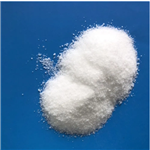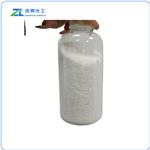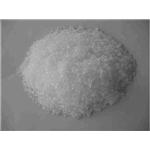Sodium chloride
- CAS No.
- 7647-14-5
- Chemical Name:
- Sodium chloride
- Synonyms
- NaCl;CHLORIDE;prop-2-en-1-amine;SALT;SALINE;SEA SALT;PAD;Sodium chloride solution;Sodium chloride (NaCl);COMMON SALT
- CBNumber:
- CB4104636
- Molecular Formula:
- NaCl
- Molecular Weight:
- 58.44277
- MDL Number:
- MFCD00003477
- MOL File:
- 7647-14-5.mol
- MSDS File:
- SDS
| Melting point | 801 °C (lit.) |
|---|---|
| Boiling point | 1465 °C/1 atm (lit.) |
| Density | 1.199 g/mL at 20 °C |
| vapor pressure | 1 mm Hg ( 865 °C) |
| refractive index |
n |
| Flash point | 1413°C |
| storage temp. | +15C to +30C |
| solubility | H2O: soluble |
| form | tablets |
| color | White |
| Specific Gravity | 2.165 |
| PH | 5.5-6.5(1 tablet in 100 mL purified water) |
| Water Solubility | 360 g/L (20 ºC) |
| Sensitive | Hygroscopic |
| λmax |
λ: 260 nm Amax: 0.02 λ: 280 nm Amax: 0.01 |
| Merck | 14,8599 |
| BRN | 3534976 |
| Dielectric constant | 5.9(Ambient) |
| BCS Class | 1 |
| Stability | Stable. Incompatible with strong oxidizing agents. |
| InChIKey | FAPWRFPIFSIZLT-UHFFFAOYSA-M |
| CAS DataBase Reference | 7647-14-5(CAS DataBase Reference) |
| Substances Added to Food (formerly EAFUS) | SODIUM CHLORIDE |
| SCOGS (Select Committee on GRAS Substances) | Sodium chloride |
| FDA 21 CFR | 107.10; 107.100; 182.70; 182.90; 310.545 |
| EWG's Food Scores | 1 |
| NCI Dictionary of Cancer Terms | NaCl; PAD; saline |
| FDA UNII | 451W47IQ8X |
| ATC code | A12CA01,B05CB01,B05XA03,S01XA03 |
| NIST Chemistry Reference | Sodium chloride(7647-14-5) |
| EPA Substance Registry System | Sodium chloride (7647-14-5) |
| Pesticides Freedom of Information Act (FOIA) | Sodium chloride |
| Cosmetics Info | Sodium Chloride |
SAFETY
Risk and Safety Statements
| Symbol(GHS) |  GHS07 |
|||||||||
|---|---|---|---|---|---|---|---|---|---|---|
| Signal word | Warning | |||||||||
| Hazard statements | H303 | |||||||||
| Precautionary statements | P270-P301+P312-P403-P501c | |||||||||
| Hazard Codes | Xi | |||||||||
| Risk Statements | 36-36/37/38-22 | |||||||||
| Safety Statements | 24/25-26-36 | |||||||||
| WGK Germany | 1 | |||||||||
| RTECS | VZ4725000 | |||||||||
| F | 3-10 | |||||||||
| TSCA | Yes | |||||||||
| HS Code | 38220000 | |||||||||
| Toxicity | LD50 orally in rats: 3.75 ±0.43 g/kg (Boyd, Shanas) | |||||||||
| NFPA 704 |
|
Sodium chloride price More Price(246)
| Manufacturer | Product number | Product description | CAS number | Packaging | Price | Updated | Buy |
|---|---|---|---|---|---|---|---|
| Sigma-Aldrich | SX0420 | Sodium chloride Meets ACS Specifications, Meets Reagent Specifications for testing USP/NF monographs GR ACS | 7647-14-5 | 12kg | $124 | 2024-03-01 | Buy |
| Sigma-Aldrich | S6150 | Sodium chloride tablet | 7647-14-5 | 100tablets | $97.8 | 2024-03-01 | Buy |
| Sigma-Aldrich | S0817 | Sodium chloride solution 0.85% | 7647-14-5 | 1gal | $51.6 | 2024-03-01 | Buy |
| Sigma-Aldrich | S0817 | Sodium chloride solution 0.85% | 7647-14-5 | 5gal | $126 | 2024-03-01 | Buy |
| Sigma-Aldrich | NIST975A | Isotopic standard for chlorine NIST?SRM?975a | 7647-14-5 | 0.25G | $961 | 2024-03-01 | Buy |
Sodium chloride Chemical Properties,Uses,Production
Crystal System
The space lattice of NaCl belongs to the cubic system, and its rock salt structure has a lattice constant of a=0.55870 nm and Na–Cl=0.27935 nm. The cleavage plane is (100).
Description
Sodium chloride is widely distributed in nature. Oceans are the vast source of sodium chloride. It occurs in seawater at an average concentration of 2.68 wt%. It also occurs in many inland saline waters and in salt deposits in sedimentary rocks, as the mineral halite.
Sodium chloride is probably the most important salt of both sodium and chlorine. Sodium chloride, common table salt, is an essential component of most food preparation, imparting flavor to food and providing the sodium nutritional requirement. Also, it is used for preserving food. Therapeutically, NaCl solution is used to combat dehydration as an electrolyte replenisher, and it is an emetic.
The most important applications of sodium chloride in the chemical industry are in making a number of important industrial chemicals such as hydrochloric acid, sodium hydroxide, sodium carbonate, and metallic sodium. It is the starting material in manufacturing these substances. Other uses are in dyeing and printing fabrics, glazing pottery, in making soap, and for curing hides. Sodium chloride is a component of many freezing mixtures.
Chemical Properties
Sodium chloride, NaCl, also known as common salt and halite, is a white crystalline solid.It is soluble in water,slightly soluble in alcohol, and melts at 804 °C (1480 °F). Sodium chloride is the most important sodium mineral and occurs naturally in seawater, underground deposits, and brine wells.Sodiumchlorideis a basic raw material for the production of chlorine,sodium hypochlorite, sodium bisulfate,soda ash, and hydrogen chloride. Sodium chloride is also used in food preparation, fertilizers, and by highway departments to control icy road conditions.
Chemical Properties
Sodium chloride occurs as a white crystalline powder or colorless crystals; it has a saline taste. The crystal lattice is a face-centered cubic structure. Solid sodium chloride contains no water of crystallization although, below 0℃, salt may crystallize as a dihydrate.
Physical properties
Sodium chloride is the familiar compound commonly referred to as salt or table salt. Th e mineral form of sodium chloride is halite and is found in natural deposits throughout the world. It accounts for approximately 2.7% by weight of the dissolved minerals in seawater. Sodium chloride is an ionic compound existing as a white crystalline cubic structure of alternating sodium and chloride ions. Sodium chloride is essential for life, with the average adult requiring about 1 to 2 grams per day. Salt supplies sodium and provides numerous essential functions such as maintaining water balance in cells, taking part in nerve signal transmission and muscle contraction.
Occurrence
Sodium chloride is widely distributed in nature. Oceans are the vast source of sodium chloride. It occurs in seawater at an average concentration of 2.68 wt%. It also occurs in many inland saline waters and in salt deposits in sedimentary rocks, as the mineral halite.
Sodium chloride is probably the most important salt of both sodium and chlorine. Sodium chloride, common table salt, is an essential component of most food preparation, imparting flavor to food and providing the sodium nutritional requirement. Also, it is used for preserving food. Therapeutically, NaCl solution is used to combat dehydration as an electrolyte replenisher, and it is an emetic.
The most important applications of sodium chloride in the chemical industry are in making a number of important industrial chemicals such as hydrochloric acid, sodium hydroxide, sodium carbonate, and metallic sodium. It is the starting material in manufacturing these substances. Other uses are in dyeing and printing fabrics, glazing pottery, in making soap, and for curing hides. Sodium chloride is a component of many freezing mixtures.
Uses
Natural salt is the source of chlorine and of sodium as well as of all, or practically all, their Compounds, e.g., hydrochloric acid, chlorates, sodium carbonate, hydroxide, etc.; for preserving foods; manufacture of soap, to salt out dyes; in freezing mixtures; for dyeing and printing fabrics, glazing pottery, curing hides; metallurgy of tin and other metals.
Uses
Used as an electrolyte; buffers ; matrix modification.
Uses
Facilitates the cross-coupling of organostannanes with iodides without using palladium.1
Uses
Used in biochemistry and molecular biology applications; a component of PBS and SSC buffers
Uses
Sodium chloride Commonly known as table salt, sodium chloride is found as the mineral halite and in brines and seawater. Sodium chloride is soluble in water but less so in alcohol. It was the first halide to be combined with silver nitrate and was also used by L. J. M. Daguerre and W. H. F. Talbot as a stabilizer before fi xing with hypo was adopted.
Uses
sodium chloride (table salt) is used as a preservative, astringent, and anti-septic to treat inflamed lesions. It can also be used to mask odor, reduce product density, and control viscosity. Diluted solutions are not considered irritating.
Definition
ChEBI: An inorganic chloride salt having sodium(1+) as the counterion.
Preparation
Sodium chloride is produced by solar evaporation of seawater or brine from underground salt deposits. It also is produced by mining rock salt. The commercial product contains small amounts of calcium and magnesium chlorides.
Definition
A compound with an acidic and a basic radical, or a compound formed by total or partial replacement of the hydrogen in an acid by a metal. In general terms a salt is a material that has identifiable cationic and anionic components.
Definition
salt: A compound formed by reactionof an acid with a base, in whichthe hydrogen of the acid has been replacedby metal or other positiveions. Typically, salts are crystallineionic compounds such as Na+Cl– andNH4+NO3-. Covalent metal compounds,such as TiCl4, are also oftenregarded as salts.
Production Methods
Sodium chloride occurs naturally as the mineral halite. Commercially, it is obtained by the solar evaporation of sea water, by mining, or by the evaporation of brine from underground salt deposits.
Definition
saline: Describing a chemical compoundthat is a salt, or a solutioncontaining a salt.
brand name
Broncho Saline (Blairex).
General Description
A white crystalline solid. Commercial grade usually contains some chlorides of calcium and magnesium which absorb moisture and cause caking.
Air & Water Reactions
Water soluble.
Reactivity Profile
Sodium chloride is generally unreactive. Releases gaseous hydrogen chloride if mixed with a concentrated nonvolatile acid such as sulfuric acid.
Fire Hazard
Literature sources indicate that Sodium chloride is nonflammable.
Flammability and Explosibility
Non flammable
Agricultural Uses
Halite is a naturally occurring sodium chloride (NaCl) deposit. The most abundant potash mineral deposit is sylvite (KCl). Sylvite with halite forms the common potash ore, called sylvinite.
Pharmaceutical Applications
Sodium chloride is widely used in a variety of parenteral and
nonparenteral pharmaceutical formulations, where the primary use
is to produce isotonic solutions.
Sodium chloride has been used as a lubricant and diluent in
capsules and direct-compression tablet formulations in the past,
although this practice is no longer common. Sodium chloride has
also been used as a channeling agent and as an osmotic agent
in the cores of controlled-release tablets. It has been used as a
porosity modifier in tablet coatings, and to control drug release
from microcapsules.
The addition of sodium chloride to aqueous spray-coating
solutions containing hydroxypropyl cellulose or hypromellose
suppresses the agglomeration of crystalline cellulose particles.(13)
Sodium chloride can also be used to modify drug release from
gels and from emulsions. It can be used to control micelle
size, and to adjust the viscosity of polymer dispersions by
altering the ionic character of a formulation.
Biochem/physiol Actions
Sodium chloride helps to stimulate the stable induction of T-helper cell 17 (TH17) cells.
Clinical Use
Treatment and prophylaxis of sodium chloride deficiency
Safety Profile
Poison by intraperitoneal and intracervical routes. Moderately toxic by ingestion, intravenous, and subcutaneous routes. An experimental teratogen. Human systemic effects by ingestion: blood pressure increase. Human reproductive effects by intraplacental route: terminates pregnancy. Experimental reproductive effects. Human mutation data reported. A skin and eye irritant. When bulk sodium chloride is heated to high temperature, a vapor is emitted that is irritating, particularly to the eyes. Ingestion of large amounts of sodium chloride can cause irritation of the stomach. Improper use of salt tablets may produce this effect. Potentially explosive reaction with dichloromaleic anhydride + urea. Electrolysis of mixtures with nitrogen compounds may form the explosive nitrogen trichloride. Reaction with burning lithmm forms the dangerously reactive sodmm. The molten salt at 11 00' reacts explosively with water. Violent reaction with BrF3. When heated to decomposition it emits toxic fumes of Cland Na2O.
Safety
Sodium chloride is the most important salt in the body for
maintaining the osmotic tension of blood and tissues. About
5–12 g of sodium chloride is consumed daily, in the normal adult
diet, and a corresponding amount is excreted in the urine. As an
excipient, sodium chloride may be regarded as an essentially
nontoxic and nonirritant material. However, toxic effects following
the oral ingestion of 0.5–1.0 g/kg body-weight in adults may occur.
The oral ingestion of larger quantities of sodium chloride, e.g.
1000 g in 600mL of water, is harmful and can induce irritation
of the gastrointestinal tract, vomiting, hypernatremia, respiratory
distress, convulsions, or death.
In rats, the minimum lethal intravenous dose is 2.5 g/kg bodyweight.
LD50 (mouse, IP): 6.61 g/kg
LD50 (mouse, IV): 0.65 g/kg
LD50 (mouse, oral): 4.0 g/kg
LD50 (mouse, SC): 3.0 g/kg
LD50 (rat, oral): 3.0 g/kg
Drug interactions
Potentially hazardous interactions with other drugs
May impair the efficacy of antihypertensive drugs in
chronic renal failure.
Metabolism
Excess sodium is mainly excreted by the kidney, and small amounts are lost in the faeces and sweat.
storage
Aqueous sodium chloride solutions are stable but may cause the
separation of glass particles from certain types of glass containers.
Aqueous solutions may be sterilized by autoclaving or filtration.
The solid material is stable and should be stored in a well-closed
container, in a cool, dry place.
It has been shown that the compaction characteristics and the
mechanical properties of tablets are influenced by the relative
humidity of the storage conditions under which sodium chloride
was kept.
Purification Methods
It is recrystallised from a saturated aqueous solution (2.7mL/g) by passing in HCl gas, or by adding EtOH or acetone. It can be freed from bromide and iodide impurities by adding chlorine water to an aqueous solution and boiling it for some time to expel free bromine and iodine. Traces of iron can be removed by prolonged boiling of solid NaCl in 6M HCl; the crystals are then washed with EtOH and dried at ca 100o. Sodium chloride has been purified by sublimation in a stream of pre-purified N2 and collected by electrostatic discharge [Ross & Winkler J Am Chem Soc 76 2637 1954]. For use as a primary analytical standard, analytical reagent grade NaCl should be finely ground, dried in an electric furnace at 500-600o in a platinum crucible, and allowed to cool in a desiccator. For most purposes, however, drying at 110-120o is satisfactory.
Incompatibilities
Aqueous sodium chloride solutions are corrosive to iron. They also react to form precipitates with silver, lead, and mercury salts. Strong oxidizing agents liberate chlorine from acidified solutions of sodium chloride. The solubility of the antimicrobial preservative methylparaben is decreased in aqueous sodium chloride solutions and the viscosity of carbomer gels and solutions of hydroxyethyl cellulose or hydroxypropyl cellulose is reduced by the addition of sodium chloride.
Regulatory Status
GRAS listed. Included in the FDA Inactive Ingredients Database (injections; inhalations; nasal, ophthalmic, oral, otic, rectal, and topical preparations). Included in nonparenteral and parenteral medicines licensed in the UK. Included in the Canadian List of Acceptable Non-medicinal Ingredients.
Sodium chloride Preparation Products And Raw materials
Raw materials
Preparation Products
1of8
| Supplier | Tel | Country | ProdList | Advantage | |
|---|---|---|---|---|---|
| Shanghai UCHEM Inc. | +862156762820 +86-13564624040 | sales@myuchem.com | China | 6710 | 58 |
| Auschemicals Pty Ltd | +61406202619 | info@auschemicals.com | Australia | 431 | 58 |
| Wuhan Han Sheng New Material Technology Co.,Ltd | +8617798174412 | admin01@hsnm.com.cn | China | 2118 | 58 |
| Henan Bao Enluo International TradeCo.,LTD | +86-17331933971 +86-17331933971 | deasea125996@gmail.com | China | 2503 | 58 |
| Hebei Jingbo New Material Technology Co., Ltd | +8619931165850 | hbjbtech@163.com | China | 1000 | 58 |
| Hebei Saisier Technology Co., LTD | +86-18400010335 +86-13102810335 | admin@hbsaisier.cn | China | 747 | 58 |
| Shaanxi TNJONE Pharmaceutical Co., Ltd | +8618740459177 | sarah@tnjone.com | China | 893 | 58 |
| Hebei Zhuanglai Chemical Trading Co.,Ltd | +8613343047651 | admin@zlchemi.com | China | 476 | 58 |
| Jiangsu Kolod Food Ingredients Co.,Ltd. | +86-518-85110578 +8618805133257 | sales3257@jskolod.com | China | 132 | 60 |
| Hangzhou Bayee Chemical Co., Ltd. | 0086-571-86990109 | rachelhoo@bayeechem.com | China | 104 | 55 |
Related articles
- Salt water: A Mixture of Nature's Elements
- Salt water, the vast expanse of saline solution covering approximately 71% of the Earth's surface, is a remarkable substance t....
- Feb 28,2024
- What is the charge for NaCl?
- NaCl is a neutral species (all chemicals you can put in a bottle are neutral). Of course,the constituent ions, Cl- and Na+ are....
- Feb 19,2024
- Why does sodium chloride produce a yellow flame?
- Halides are typically more volatile than other salts, making them good for this test. Sodium chloride (NaCl) gives a bright ....
- Jan 25,2024
Related Qustion
- Q:Does Saline solution expire?
- A:Physiological sodium chloride solution normally has a shelf life of 24 months. Deterioration and bacterial growth will usually....
- Mar 5,2024
View Lastest Price from Sodium chloride manufacturers
| Image | Update time | Product | Price | Min. Order | Purity | Supply Ability | Manufacturer | |
|---|---|---|---|---|---|---|---|---|
 |
2024-04-26 | Sodium chloride
7647-14-5
|
US $120.00 / ton | 5ton | 99% | 3000tons | Hebei Dangtong Import and export Co LTD | |
 |
2024-04-22 | Sodium chloride
7647-14-5
|
US $100.00 / kg | 1kg | 99 | 5000 | Hebei Zhuanglai Chemical Trading Co.,Ltd | |
 |
2024-04-12 | Sodium chloride
7647-14-5
|
US $6.00 / KG | 1KG | More than 99% | 500KG/Month | Hebei Saisier Technology Co., LTD |
-

- Sodium chloride
7647-14-5
- US $120.00 / ton
- 99%
- Hebei Dangtong Import and export Co LTD
-

- Sodium chloride
7647-14-5
- US $100.00 / kg
- 99
- Hebei Zhuanglai Chemical Trading Co.,Ltd
-

- Sodium chloride
7647-14-5
- US $6.00 / KG
- More than 99%
- Hebei Saisier Technology Co., LTD
7647-14-5(Sodium chloride)Related Search:
1of5










